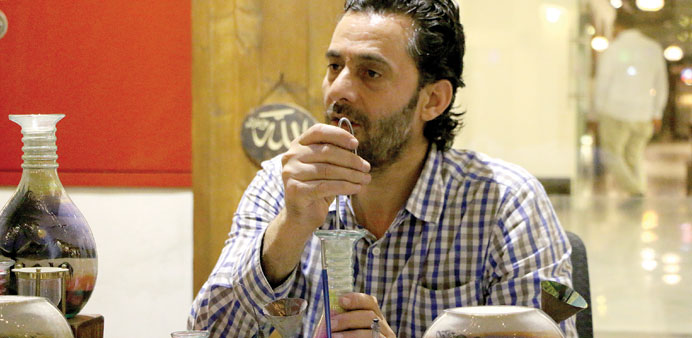PREPARED: Abodai keeps all his tools ready. Photos by Umer Nangiana
By Umer Nangiana
The desert sand when blowing in the form of storms is dangerous. The same gusty sand, however, offers endless possibilities for creativity when it is contained in a bottle. For Ameen Abodai, this sand means business. He earns his livelihood from it.
Abodai, an artist from Syria working at Souq Waqif Art Centre, creates colourful sand art bottles which are popular beach souvenirs and decoration pieces. He collects sand, dyes it and puts it in bottles of different sizes and shapes, creating intriguing designs.
This Syrian artist, sitting along the side of the main Souq Waqif street outside the art centre, is a major attraction for tourists who purchase the sand art bottles customised with their names and their favourite designs.
He is trained as an artist but picked up the art of creating sand bottles from his father. “I have been doing this for 25 years now. I went to an art school where I did not learn sand art in specific but I did learn drawing, painting, sculpturing and calligraphy,” Abodai tells Community.
“But my father was into this kind of art and he used to make colourful sand bottles in different shapes and patterns. So I learnt from him,” recalls the artist.
For him the job is very easy now. However, he says it never bores him as he keeps changing style and patterns. Abodai shows how he creates a sand art bottle right in front of his customers within a few minutes, inscribing their names with the sand inside the bottle, visible from the front in the transparent bottle.
He has a cone-shaped funnel that he holds inside the neck of the bottle with one hand, and use a teaspoon to add the first colour of sand a little at a time. Jiggling the funnel gently, in case the sand gets clogged in it, he starts making his design, slowly adding more sand as he progresses.
Now, he examines the layers and has patterns in mind. He moves on to create coloured sand stripes in flat, horizontal and diagonal patterns, holding the bottle at an angle and tapping it so that all the sand rests in one corner.
He continues adding layers of sand in different colours, taking care not to move the bottle around too much or too quickly, as this causes the colours to mix together and destroy the layered look, he says. He uses the point of the funnel to direct each layer of sand into position. He stops when the bottle is full of layers of coloured sand. He then applies hot glue to the inside of the bottle neck and inserts a cork. The bottle is ready.
Sometimes Abodai’s customers simply want his premade patterns in different sizes of bottles. Others want customisation and give him pictures to draw from. He does it right in front of them if the order is small. For bigger orders, he takes a few hours or days.
“It is very interesting. If you have to make a camel inside the bottle of sand, it goes like this. You create one leg, then the other, then stretch it like this,” Abodai demonstrates one of his many techniques of drawing pictures inside the bottle with coloured sand.
“You have different colours of sand already available at hand with you. All you need to do is to create a picture after pouring the sand into the bottle,” he says.
Abodai sells the bottles from QR50 to QR250 depending on the quality of artwork on it and the size of the bottle. “For me it has become very easy but I do not know if others find it difficult or easy to make these bottles,” says the artist.
The bottles he uses are made of glass and plastic in China, and come in different shapes and sizes. The sand he collects from beaches and then colours it.
He says he has been working at Souq Waqif Art Centre for two years and the business is very good. He gets customers from India, Pakistan, Bangladesh, Europe, America and even Qataris. Some of his customers are such fans of his work that they purchase the bottles in bulk.
Abodai says he can make company logos, people’s names and even put pictures inside the bottles with the help of his scalpel.



